
The air disaster of 1943
A very detailed account, The Winslow Air Disaster 1943 by Bert Shrimpton (1993), is available in Winslow Library and the Centre for Bucks Studies. The report on the right is from The Times, 9 August 1943 The crash took place in the early hours of 7 August 1943. A Wellington X3790 Mark III bomber of 26 Operational Training Unit was, according to the survivor's account, making a second attempt to land at Little Horwood Airfield. The crew was:
|
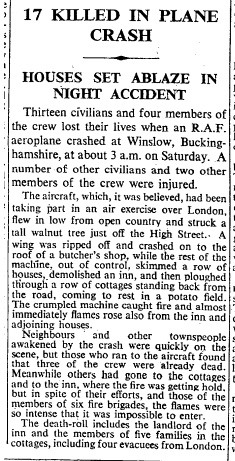 |
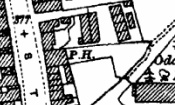 |
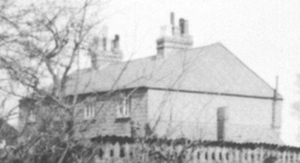 The map shows the Chandos Arms ("P.H.") and Rose Cottages (the four houses top right), east of the High Street. The Oddfellows Hall (bottom right corner) is in roughly the same place as the present Public Hall, but the rest of the site has been replaced by Elmfields Gate, modern buildings and the car park. The photo on the right, taken not long before the disaster, shows Rose Cottages from the footpath near the Oddfellows Hall.
Click here for more about the Chandos Arms and Rose Cottages. The map shows the Chandos Arms ("P.H.") and Rose Cottages (the four houses top right), east of the High Street. The Oddfellows Hall (bottom right corner) is in roughly the same place as the present Public Hall, but the rest of the site has been replaced by Elmfields Gate, modern buildings and the car park. The photo on the right, taken not long before the disaster, shows Rose Cottages from the footpath near the Oddfellows Hall.
Click here for more about the Chandos Arms and Rose Cottages. |
There were 13 civilian fatalities:
- Thomas Cox, landlord of the Chandos Arms
- Tom Paintin of 82 High Street and his son Donald
- William and Nora Hawkins
- Stephen and Doris Mullis and their children Terence and Kathleen
- Israel and Annie Goldberg, their daughter Lottie Hoberman and her son Victor; the family had been evacuated from Stoke Newington
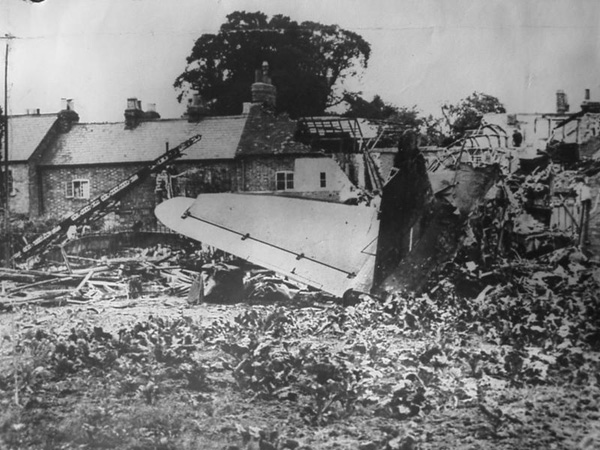
The houses in the photo are in the High Street. Rose Cottages have disappeared beneath the plane.
This account has been provided by Jeffrey Harrington:
On the night of 6/7th August 1943 I was the navigator of Wellington Bomber X3790. Wilfred Davies was pilot with Johnny Sowter bomb aimer. The wireless operator air gunner was John McKeon who had replaced Samuel Smith, killed on 31st July. The rear gunner was Carl Fietz, an Australian, locum for our regular gunner who was hospitalised. We took off from Little Horwood airfield (which is at Great Horwood!) on a training bombing exercise. We had already secured the Bomber Command record for bombing with an average error of 30 yards, with eight bombs from 10,000 feet at night but we were hoping to better the record. When we were approaching the bombing range Johnny Sowter discovered the bomb sight to be defective and we aborted the exercise and altered course for base. During the subsequent approach down the glide path to the runway I heard the pilot say he had ‘got a red’. Now there were a number of things which that could indicate. A Verry light from the airfield controller, being off the glide path or maybe some instrument reading. My compartment in the Wellington was just in front of the main spar and thus I was unable to know exactly what was occurring ‘up front’. The pilot called to Johnny to help him and I monitored my instruments that showed a very low airspeed and height. We seemed to waffle and yaw about for a couple of minutes and then there was a thump! The time was 2.55am (August 7th the day before my nineteenth birthday). I awoke on the edge of a conflagration the like of which I had never seen and to the sounds from a nightmare. I managed to attract attention to my position by blowing my whistle and some men came and lifted me over some spiked iron railings and took me to a cottage. I had lost my senses for I had not the remotest idea where I was - which country - was it Germany? I ask the people in the cottage "where was I?" but they seemed reluctant to say. I said "is this England?"’ They replied in the affirmative and I knew all would be well. I was offered succour but declined any treatment to my burns until the RAF ambulance arrived. I was injected with morphine and taken to Halton hospital where I remained for some time. At the 50th anniversary memorial I introduced myself to two ladies, June Ridgeway and Sheila Barnes, who had been the Mullis sisters aged about five or six and were the only survivors of their family living in Rose Cottages. Their story was revealed in a television interview and in talks with me. I contacted the Veterans Agency on their behalf and they were subsequently awarded war disability pensions.
The picture above is of a navigator in a typical navigator’s compartment, not a Wellington though. Jeffrey Harrington ex Sgt Navigator 1319285 |
Some of the aftermath is shown in the photo below. The building in the background is the Oddfellows Hall.
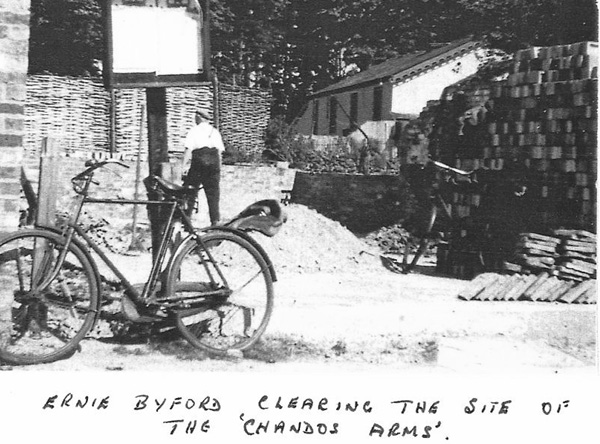
Ernie Byford's daughter Mavis recalls the night of the crash: MP3 file (05:13) ![]()
The photo below seems to have been taken later than the one further up the page, if you compare the wing of the plane in the two. The building must be what was left of Rose Cottages.
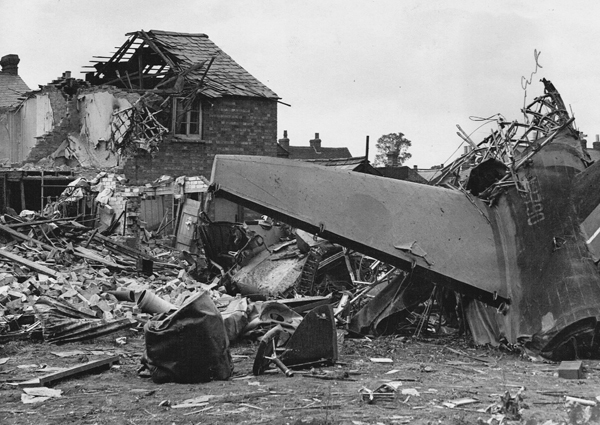
You can read the coverage in the Buckingham Advertiser (JPG files):
- initial report (14 August 1943)
- report of the funerals
- report of the inquest (large file: 4.1 MB)
Survivors included the occupants of 2 Rose Cottages, William and Louisa Phillips, and Louisa's father Jabez Sawyer aged 80.
- newspaper report annotated by a member of the Sawyer family (PDF file, 1.1 MB, with thanks to David Sawyer)
An RAF court of enquiry found that the accident was due to the pilot losing control through not concentrating on his instruments and allowing the aircraft to fly too low, and blamed Flying Control for allowing crew with insufficient experience to participate in night flying exercises.
A special service to commemorate the 50th anniversary of the disaster was held at Winslow in 1993, and made the regional news. Click here to see the Meridian T.V. report.
There is now a memorial plaque on the Royal British Legion Hall:
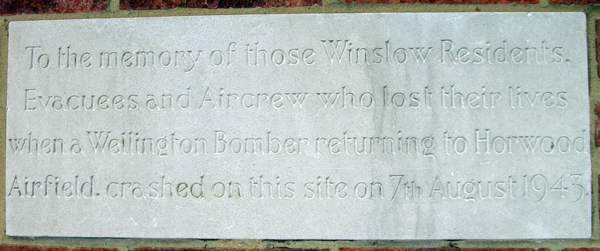
See also:
- Winslow in the 20th Century
- Commonwealth War Graves: you can now search for civilian casualties in their database, e.g. Nora Hawkins
- Findagrave virtual cemetery created by Andy Cooke: links to information about all the casualties including photos of the graves

